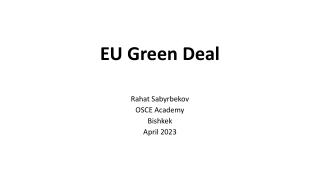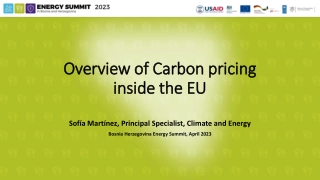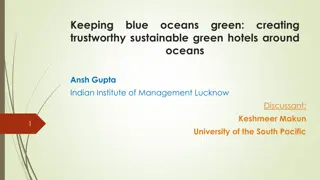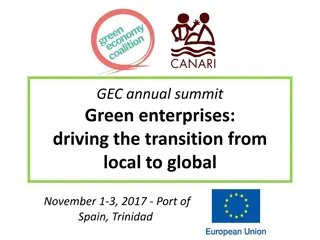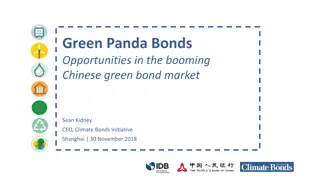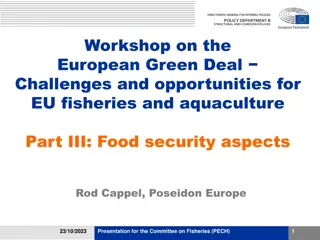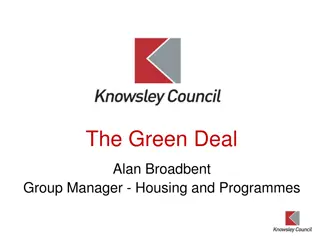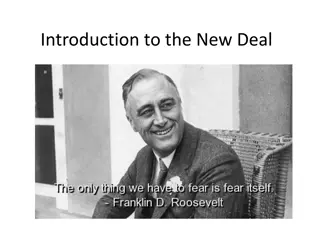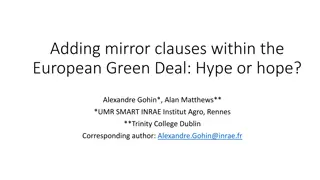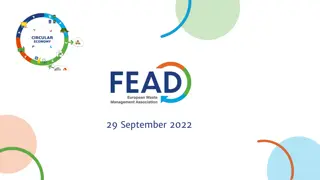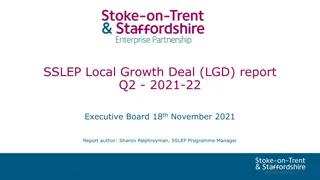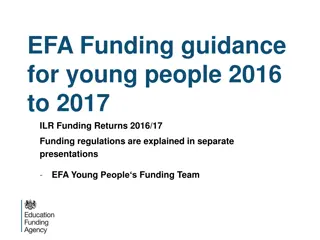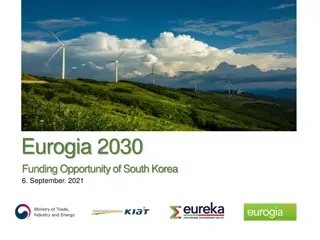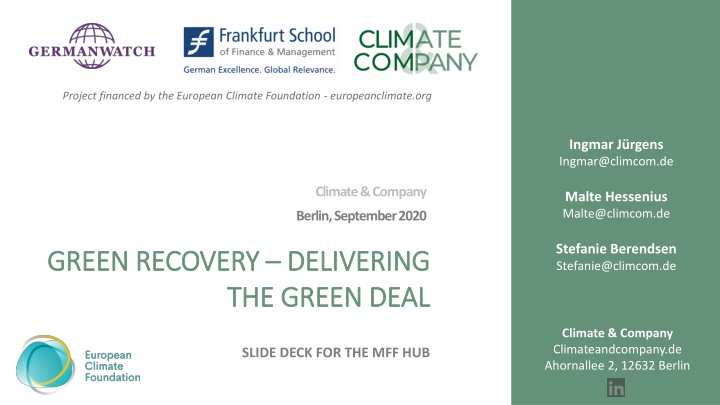
Delivering the Green Deal and Analyzing Next Generation EU Funding
Dive into the European Climate Foundation's project financed initiatives and the strategies employed to operationalize the do-no-harm principle. Explore the EU Taxonomy as a pivotal tracking tool, structural reforms, and funding mechanisms to achieve climate neutrality and foster a just transition. Analyze the gaps in investment targets and the role of cash budgets, grants, guarantees, loans, and dedicated climate facilities in EU funding frameworks.
Download Presentation

Please find below an Image/Link to download the presentation.
The content on the website is provided AS IS for your information and personal use only. It may not be sold, licensed, or shared on other websites without obtaining consent from the author. If you encounter any issues during the download, it is possible that the publisher has removed the file from their server.
You are allowed to download the files provided on this website for personal or commercial use, subject to the condition that they are used lawfully. All files are the property of their respective owners.
The content on the website is provided AS IS for your information and personal use only. It may not be sold, licensed, or shared on other websites without obtaining consent from the author.
E N D
Presentation Transcript
Project financed by the European Climate Foundation - europeanclimate.org Ingmar J rgens Ingmar@climcom.de Climate & Company Malte Hessenius Malte@climcom.de Berlin, September 2020 Stefanie Berendsen Stefanie@climcom.de GREEN RECOVERY GREEN RECOVERY DELIVERING THE GREEN DEAL THE GREEN DEAL DELIVERING . . Climate & Company Climateandcompany.de Ahornallee 2, 12632 Berlin SLIDE DECK FOR THE MFF HUB Gray linkedin 3 icon - Free gray site logo icons
Outline Introduction (Overview and Investment Needs) How to operationalize the do no harm principle? 1. The EU Taxonomy as a science-based tracking tool (vs. Rio marker) 2. Governance 3.
Delivering the Green Deal Regulation & Structural Reforms Goal Financing Capacity building Climate neutrality and just transition European Semester: CSRs, AMR, MIP MFF and RRF DG REFORM Resilient recovery and competitiveness Energy Union Integrated governance for policy coherence Mobilise DG Reform to support MS with green investment MFF and RRF aligned with the Green Deal Re-calibrate the European Semester for the Green Deal
Analysis of Next Generation EU and the MFF 2021-27:1 The 25% climate target leaves a large investment gap (1/3) 1) Analysis based on the COM s proposal, 27 May 2020; Figure: Juergens, I., Berendsen, S., Hessenius, M., & Rusnok, D. (2020). More info via this link.
which would increase even more if the changes of the EUCO are considered (2/3) The volume of climate facilities have decrease substantially Immediate Cash budgets Much flexibility for MS Sum of NGEU (2021-2024) and MFF (2021-27) 1 27 May COM Proposal 21 July EUCO decision Large potential role, if used wisely all depends on governance! Grants Guarantees Loans Grants Guarantees Loans Large Cash budgets Facilities with more climate dedication RRF 310 250 312.5 360 ReactEU 50 47.5 JTF key for transitions regions InvestEU taking on risks Facilities with more climate dedication Horizon early stage innovation processes Just Transition Fund (JTF) 40 20 Invest EU 31.6 6.9 From 166 bn EUR to 112.8 bn EUR! Horizon Europe 94.4 85.9 Decrease by ~ 33%! 1) The MFF & NGEU figures from the COM s proposal from May 27 are extracted from COM(2020) 442 final (link). The changes in NGEU figures come from the EUCO conclusions (link).
and even if a climate share of 40% is assumed, the EU budget covers less than half of the required 2.4 trillion EUR (3/3) 1) Source: Figure 3, Agora Energiewende (2020) Recovering better (link); Note: The 2.4 trillion EUR investment gap even stems from a lower level of ambition.
How to mobilise MFF and RRF for the green deal Do no harm principle, Taxonomy and effective governance Taxonomy for carbon accounting in the EU budget I Operationalization of the do no harm principle II [The MFF and NGEU] shall comply with the objective of EU climate neutrality by 2050 and contribute to achieving the Union's new 2030 climate targets, which will be updated by the end of the year. As a general principle, all EU expenditure should be consistent with Paris Agreement objectives. (Source: EUCO conclusions; I Next Gen EU, Art 21) [ ] An effective methodology for monitoring climate-spending and its performance, including reporting and relevant measures in case of insufficient progress, should ensure that the next MFF as a whole contributes to the implementation of the Paris Agreement. [ ] (Source: EUCO conclusions; Annex I, paragraph 18) [ ] EU expenditure should be consistent with Paris Agreement objectives and the "do no harm" principle of the European Green Deal [ ] [ ] (Source: EUCO conclusions; Annex I, paragraph 18) Apply do no significant harm principle to all budget lines. (I) Use Taxonomy as a science-based tracking tool. (II) Need for effective governance III NECPs National Reform Plans Policy coherence requires integrated governance! (III) Recovery and Resilience Plans Just Transition Plans
Outline How to operationalize the do no harm principle? 1. The EU Taxonomy as a science-based tracking tool (vs. Rio marker) 2. Governance 3.
Do no harm principles exist already in MFF budget lines but Do no harm principles exist already in MFF budget lines but are not comprehensive and inconsistent are not comprehensive and inconsistent ERDF and Cohesion Fund [COM(2018)372] Article 6: nuclear, tobacco, airport infrastructure (except for outermost regions); disposal of waste in landfill; fossil fuels (exception of investment related to clean vehicles as stated in Art. 4, Directive 2009/33/EC) Invest EU, Annex V [COM(2020) 403 final] Human rights, tobacco, gambling, sex trade, Investments related to fossil fuels and gas, except: a) projects with no viable alternative technology, b) projects related to pollution prevention and control; c) CCS/CCU and research projects leading to substantial GHG emission reduction Just Transition Fund, Article 5 [COM(2020) 22 final] Nuclear, tobacco, fossil fuels, broadband infrastructure in areas with at least two networks of equivalent category
Ensuring consistency with Paris Agreement objectives through sectoral exclusion criteria A first attempt based on existing work Industry Energy Supply Transport Buildings Agriculture / Forestry 20% of EU emissions, high risks of lock in 30% of EU emissions, key to electrify processes 22% of EU emissions 13% of EU emissions 12% of EU emissions Nuclear, fossil fuels, gas1 Expansion of aviation capacity and motorways2 Fossil-fuel based heating appliances3 Production of agricultural products on land obtained as a result of deforestation of primary forest [ ] after the year 20001 Production of fluorinated GHG with a Global Warming Potential (GWP) of >1501 Crop-based biofuels and unsustainable bioenergy2 Internal combustion engine vehicles2 DNSH criteria from the EU Taxonomy (e.g. new building must comply with all applicable mandatory national/regional regulations regarding energy & carbon performance)4 No activity can have emissions intensity above the average emissions (regional)4 Chemical manufacturers unless for safe and sustainable chemicals2 LNG and diesel maritime vessels (except substantial GHG improvements)2 Livestock farming, unless organic or extensive (<0.7 LSU/ha)2 No support for coal/heavy- fuel oil/ fossil gas as fuel or feedstock3 [ .] Fossil gas (LNG/CNG) infrastructure for transport2 Timber production unless operator demonstrates that harvest is covered by valid licences and not from primary forest with high biodiversity value & carbon stock.1 [ .] No support for electricity- intensive processes without a plan to green power sources by 20303 All DNSH criteria from the EU Taxonomy (e.g. Emissions performance threshold of > 95g CO2 e /pkm for passenger cars)4 GHG emissions are higher than the average global emissions for that activity4 DNSH criteria from EU Taxonomy.4 1) As stated in the Ecolabel exclusion criteria (link );2) as suggested by the G-10 (link) ; 3) Climate & Company (2020) Study for Agora (link); 4) Taxonomy, DNSH to objective mitigation (part of the climate change adaptation Taxonomy) // Note: Plus, there are overall exclusion activities by the IFC World Bank Group (link) or the KfW (link).
Outline How to operationalize DNSH? 1. The EU Taxonomy as a science-based tracking tool (vs. Rio marker) 2. Governance 3.
If the climate share is not measured accurately, it cannot be effective 1 An adaptation of the Rio Markers is currently used1 Classification Examples Renewable energy projects, energy efficiency measures, cycling and footpaths, etc. Railway investments, air quality measures, multimodal transport, etc. - The significant and moderate assessment is largely subjective, almost arbitrary by times. Significant (100%) The European Court of Auditors massively criticized the approach, along with a range of leading experts in the area! Moderate (40%) Insignificant (0%) 2 Agriculture as a negative example1 Climate Share % Climate Spending bn EUR Given an EU budget of 1.1 trn EUR, and a climate share of 25% (=275 bn EUR)... Facility Volume bn EUR agriculture makes up ~ 50% of climate spending. But the actual and effective contribution of agriculture to reducing emissions is unclear, difficult to track! Europ. Agric. Guarantee Fund (EAGF) 258.3 40% 103 Europ. Agric. Fund Rural Development (EAFRD) 90 40% 36 Sources: 1) based on the current MFF 2021-27 and the documents published in 2018.
Taxonomy vs. Rio markers in practice Current methodology 1 Facility Example Tracking via Taxonomy Only counts as a climate spending if primary energy demand is reduced by >30% of the building. Energy efficiency renovation of the existing building stock1 Classified as significant ; 100% contribution ( no matter how much the energy efficiency increased) E.g. non-electrified rail infrastructure only counts with an existing plan for electrification or use of alternatively powered trains. Cohesion Funds Classified as significant (100%) Newly built railways1 Counts if ICT solutions are exclusively aimed at decision making enabling GHG reductions ICT, data collection1 Classified as insignificant (0%) Classified as significant (100%) for example: a payment per hectare for environmental practices (eco-scheme design depends on each Member State!) E.g. livestock production only counts if activity is in line with an ambitious emissions reduction trajectory till 2050 Agricultural Facilities Eco-schemes2 1) As specified in COM/2018/375 final - 2018/0196 (COD).; 2) As specified in COM/2018/392 final 2018/0216 COD, Article 87, (link)
Applying the Taxonomy time pressure asks for pragmatic solutions How to operationalize the EU Taxonomy? Performance-based incentive schemes possible e.g. climate conditionality Taxonomy compliance as condition for public support or If an activity falls under the EU Taxonomy e.g. forward-looking disclosure. Grant elements in case of Taxonomy compliance Medium-term decarbonisation pathways and reporting aligned with Taxonomy If a company falls under the EU Taxonomy Company/Activity not covered but potentially contributes significantly to EU objectives Starting points See above and do no harm DNSH of the Taxonomy Exclusion List Ecolabel Do-No-Harm and exclusion criteria to ensure climate neutrality Letter of G10 All others EIB Lending Guidelines ( )
The scope of the EU Taxonomy for EU-27 firms1: only 28% of market value of publicly listed EU firms is exposed to a Taxonomy evaluation EU27 thereof Taxonomy sectors" thereof Taxonomy sectors" (market capitalisation) # Firms (absolute) NACE Sector A - Agriculture & Forestry 59 45 0.1% C - Manufacturing 1929 407 11.4% D - Electricity 110 91 4.3% E - Water 47 42 0.3% F - Construction 289 242 1.8% H - Transportation and storage 124 62 1.5% J - Information and Communication 754 325 5.4% L - Real Estate 445 445 3.3% 3757 1659 28.1% K - Financial and insurance 660 19.5% Other sectors (no Taxonomy relevance) 1354 10.7% 5771 30.2% 1) Only publicly listed firms. Taxonomy mapping solely based on the primary activity classified via NACE codes. Other business segments are neglected.
Outline How to operationalize DNSH? 1. The EU Taxonomy as a science-based tracking tool (vs. Rio marker) 2. Governance 3.
Delivering the Green Deal Regulation & Structural Reforms Goal Financing Capacity building Climate neutrality and just transition European Semester: CSRs, AMR, MIP MFF and RRF DG REFORM Resilient recovery and competitiveness Energy Union Integrated governance for policy coherence Mobilise DG Reform to support MS with green investment MFF and RRF aligned with the Green Deal Re-calibrate the European Semester for the Green Deal
Smart and Transparent use of Public Money Intelligent climate share (e.g. taxonomy based) Disclosure for recovery and MFF beneficiaries (NFRD) Boost green Boost green deal Boost green investment investment (investment) Mobilise/facilitate key role of government in leading and stimulating innovation Aligned and integrated governance Financial Resources Integration of key EU (governance) frameworks (European Semester & RRF, Energy Union & JTM Leverage to reach goals Governance Mechanism Goals Goals Structural Reforms & Regulatory Framework Greening the European Semester (e.g. Scoreboard, alert mechanism report, MIP, CSRs) Mobilisation of private finance Recover and build Build resilience Build resilience resilience Capital raising plans Green investment capacity building: Strengthening DG REFORM s green capacity Regional investment hubs
The RRF and its firepower are at the heart of the next MFF: RRPs as the new blank sheet to direct public resource Evaluation criteria Article 16 RRPs Article 15 Risk Challenges identified in Eur. Semester a) Does the plan address the CSR? It is sufficient to address either green or digital criteria in the RRPs (see Annex II, COM proposal) b) green and digital transitions * Growth potential, jobs, social impact, green and digital c) lasting impact on MS RRPs Evaluation criteria are only vaguely defined Growth potential, jobs, social impact Are estimated total costs reasonable? Milestones, targets, investment projects d) Example: significantly contribute to establish climate- and environmental- friendly systems ( ) e) Total costs of the reforms Reforms & public investment projects f) [and more .] g) Effective implementation? *Draft Report by ECON-BUDG (01.09.20) has already proposed to split green and digital in separate criteria
Potential Elements of an Integrated Governance Mechanism for the Green Deal Coordinating RRP guidance Monitoring Similar to MIP (macroeconomic imbalance procedures) exploring whether and in what format an Environmental Scoreboard could be of value (e.g. stronger integration with NECPs) Improved tracking of climate shares Use Budgetary surveillance (including national plans): consistency with the green deal Transparency - using the Taxonomy and the non-financial disclosure framework to monitor the set climate share only investments that fulfil the evaluation criteria can qualify as green MFF and NGEU must avoid harm thus, the do no harm principle should apply to all investments1 by building on sectoral exclusion lists could be operationalised relatively quickly and reforming the much-criticized current approach based on Rio markers Providing recommendations through established European Semester structure and support at national level Capacity building (e.g. National centres of Excellence and regional hubs approach) MFF climate share commensurate with investment needs Green capacity booster for DG REFORM 1) As recommended by the statement of the TEG 5 high-level principles for Recovery Resilience 1) As recommended by the statement of the TEG 5 high-level principles for Recovery & Resilience
Monitoring: Capturing environmental factors through the European Semester Proposing an environmental scoreboard in support of the European Semester s Macroeconomic imbalance procedure scoreboard (MIP) to strengthen the implementation of the Green Deal on the national level ENV Scoreboard MIP Scoreboard Similarly, an environmental scoreboard is suitable to serve as an early warning system tracking whether MS are on track with the green transition and helping to identify whether additional policy action on the national level is needed In the ES cycle, the MIP scoreboard underpins the Alert Mechanism Report, which identifies whether MS are affected by imbalances and in need of policy action
The case for an Environmental Scoreboard in the ES Main topic of the ES in recent years has been the lack of investments, delivering the Green Deal requires the ES to re-gear to address the lack of green investments Delivering the EU Green Deal needs structural reforms and targeted investments Covid-19 has put even more pressure on delivering the EU Green Deal, but has also led to increased public spending which limits the fiscal space in the future Progress on the EU Green Deal needs to monitored closely and supported when necessary EU needs to be able offer guidance and spot the need for additional policy action quickly Early warning system allows for early corrective action Environmental Scoreboard supports of the NECP implementation and review Exactly matches the governance logic of the European Semester. Climate tracking (e.g. with the Taxonomy) offers an ex-ante approach, the scoreboard supports it by working on a ex-post basis Increased transparency and accountability of Member States Increased future resilience through integrated governance regimes
Current MIP Scoreboard (2020) Indicators Auxiliary Indicators Real gross domestic product (GDP) Gross fixed capital formation Gross domestic expenditure on research and development Current plus capital account (Net lending-borrowing) Net international investment position excluding non-defaultable instruments Foreign direct investment in the reporting economy (flows) Foreign direct investment in the reporting economy (stocks) Net trade balance of energy products Real effective exchange rate - Euro Area trading partners Export performance against advanced economies Current account balance - % of GDP Net international investment position Real effective exchange rate - 42 trading partners, HICP deflator Export market share - % of world exports Nominal unit labour cost index (2010=100) House price index (2015=100) deflated Terms of trade (goods and services) Export market share, volumes Labour productivity Gross non-performing loans of domestic and foreign entities Unit labour cost performance relative to Euro Area House price index (2015=100) nominal Residential construction Household debt, consolidated (including NPISH) Consolidated banking leverage, domestic and foreign entities Employment Activity rate - % of total population aged 15-64 Long term unemployment rate - % of active population aged 15-74 Youth unemployment rate - % of active population aged 15-24 Young people neither in employment nor in education and training - % of total population aged 15-24 People at risk of poverty or social exclusion - % of total population People at risk of poverty after social transfers - % of total population Severely materially deprived people - % of total population People living in households with very low work intensity - % of total population aged 0-59 Private sector credit flow consolidated Private sector debt consolidated General government gross debt Unemployment rate Total financial sector liabilities - non-consolidated Activity rate - % of total population aged 15-64 Long term unemployment rate - % of active population aged 15-74 Youth unemployment rate - % of active population aged 15-24 Gross domestic product (GDP) at market prices None of the indicators relevant for reaching energy and climate targets included Link to Source
The European Semester structure Current MIP Scoreboard does not include any environmental sustainability or green transition related indicators Tracking of environmental progress in ES structure generally limited (few and mostly energy-focused indicators) Shortcomings Green recovery is a declared priority in the EU the European Semester needs to reflect that European Semester suited to mainstream climate action and monitor climate action as well green investment gap European Semester structure is a well-established governance regime and fosters a continuous dialogue between the European Commission and Member States Opportunities Re-gearing monitoring system and the ES more broadly towards the Green Deal offers far-reaching effects
Environmental Scoreboard Indicators relevant for macroeconomic stability Indicators relevant for delivering the Green Deal Indicators tracking size and investment of green economy A range of environmental indicators are relevant to macroeconomic stability For example: Risk of stranded assets Flood risk Heat stress Alignment with goals and targets of NECPs Update due in 2024 Sector-relevant indicators tracking private and public (green) investment More than 150 environmentally relevant indicators already tracked across different EU governance regimes Indicators chosen to reveal need for policy action--E.g. lack of relevant (public) infrastructure investments, etc.
Environmental Scoreboard proposed by IEEP (2020) 1 Size of the green economy Private Investment, jobs and gross value added related to circular economy sectors Environmental goods and service sector Gross value added from market output of the EU environmental economy Employment from market output of the EU environmental economy Green gross fixed capital formation/GDP Private investment, jobs and gross value added related to low-carbon and circular economy sectors 2 Long-term sustainability of the economy Natural capital accounting indicators: Share of forest area Soil seal index Water bodies in good ecological status (%) Water exploitation index Indicators for Good Environmental Status of Marine Waters Absolute decoupling indicators Additional indicators measuring also the human, social and financial/physical capitals 3 Sustainable public finance Environmental protection expenditure of the public sector by type (environmental investments, environmental current expenditure and environmental subsidies/transfers) Contribution to the international 100bn USD commitment on climate-related expending Indicators of climate and biodiversity mainstreaming of public budgets at MS level based on an improved EU methodology for the MFF 4 Green incentives, taxes and subsidies Fossil fuel subsidies Environmental tax revenues Green public procurement as share of total public procurement CE Action Plan Eurostat Eurostat Eurostat to be developed to be developed Eurostat Eurostat Eurostat Eurostat to be developed to be developed to be developed Eurostat Eurostat to be developed IMF Eurostat to be developed Source: Charveriat, C. and Bodin, E. (2020) Delivering the Green Deal: the role of a reformed Semester within a new sustainable growth strategy for the EU, the Institute for European Environmental Policy (IEEP). Link
Environmental Scoreboard proposed by IEEP (2020) 5 Measuring green R&D and Innovation Eco-innovation index Number of patents related to recycling and secondary raw materials 6 Sustainable Industry Industrial emissions intensity Greenhouse gas emissions from transport Greenhouse gas emissions from agriculture Domestic material consumption per capita Energy consumption in households Generation of waste excluding major mineral waste Per capita waste generation Material footprint per capita Greenhouse gas emissions of the digital sector Greenhouse gas emissions of the chemical sector Level of take-up in corporate sustainability schemes (such as EMAS) 7 Climate Change Risk Risks to human capital: Years of life lost due to exposure to particulate matter Economic risks: Climate-related economic losses Climate adaptation & DRR expenditures as a share of GDP Public funding for just transition Indicators for Integrating climate-related risks into financial stability monitoring and microsupervision 8 Negative spill-over effects of Europe's economic and industrial policies on third countries' decarbonisation pathways to be developed DG-ENV Eurostat Eurostat Eurostat Eurostat Eurostat Eurostat CE action plan EEA to be developed to be developed to be developed to be developed Eurostat, EEA) Eurostat, SDGs to be developed to be developed to be developed Source: Charveriat, C. and Bodin, E. (2020) Delivering the Green Deal: the role of a reformed Semester within a new sustainable growth strategy for the EU, the Institute for European Environmental Policy (IEEP). Link
Project financed by the European Climate Foundation - europeanclimate.org For questions or further information please contact: Ingmar J rgens Ingmar@climcom.de Berlin, September 2020 Malte Hessenius Malte@climcom.de THANK YOU ! Stefanie Berendsen Stefanie@climcom.de Climate & Company climateandcompany.de Ahornallee 2, 12632 Berlin
Without strong guidance and governance, national implementation incoherent Example: Investment chapter of the National Energy and Climate Plans Countries Final NECPs Quality degree Remarks Differentiating between national / EU / private Investment & green finance for different subsectors Austria 1. Comprehen sive analyse Comprehensive strategy including Energy Agreement (0,5 billion EUR), Denmark s Green Future Fund (4 billion EUR) and including financing from Danish private pensions funds to support the green transition (50 billion EUR) Relevance Denmark NECPs key document to reach climate targets Sources: ESIF, EFSI, Modernization Fund, Innovation Fund, EU Allowance auctioning. EIB and EBRD mentioned. No analysis of amounts. Croatia Analysis of final NECPs reveals low quality Czech Republic Comprehensive analyse of EU budgets. Multiannual Financial Framework, Selling Allocations. Private sector unclear. 2. Incomplete Approach, e.g. Brussels pays all approach Inconsitencies between financing chapters of different countries Financing under the EU long-term budget framework 2021-2027 (Multiannual Financial Framework) Estonia Especially ERDP (10 billion EUR for Greece) and Cohesion Fund (3,6 billion EUR) under consideration of national co-financing requirements Course of Action Greece Build connections between the European Semester, NECP-relevant ministries, scientific community and financial sector Latvia EU-Funds, Eu-Allowances Auctioning, National budgets. Slovakia ERDF, ESF+, Cohesion Fund, etc. Finland No information provided. Italy No information provided. 3.No Capacity development: know-how to finance the NECPs and raise private capital information provided Malta will reduce CO2-emissions in the transport sector with blending biofuels with diesel. Malta provides information on additional costs for car users. Malta

